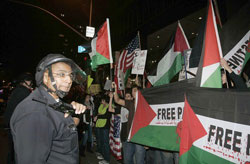When local protests broke out this month over the Israeli invasion of Gaza, Los Angeles Police Department officials decided that officers at the scene should not immediately wear their riot helmets out of concerns the gear might escalate passions among the demonstrators.

Officers wear helmets during a Dec. 30 protest in front of the Israeli Consulate. At a protest Jan. 10, officers were told to skip the gear unless tensions grew.
Some officers and the Police Protective League have expressed complaints about a decision at a Westwood protest that riot gear should not be worn unless the demonstration escalated.
But the decision has now generated controversy after a protester hit an officer with the wood post of a protest sign during a march in Westwood.
The unidentified Hollywood Division officer, who was not wearing a helmet, crumpled to the ground and was later taken to a hospital after complaining of dizziness.
He is expected to make a full recovery, but the incident has drawn complaints from other officers and the Police Protective League about the LAPD's policy of limiting when tactical gear is worn during demonstrations.
Over the last decade, there has been running disagreement within the LAPD about when and where to deploy so-called tactical gear (in police parlance "hats and bats") and whether the equipment officers wear can itself change the dynamics of a crowd.
Some argue that for those exercising free speech, the gear is intimidating and anxiety provoking, suggestive that police are poised and primed to battle it out with the crowd.
But to officers, helmets, face guards, gas masks and vests are protection, basic necessities that stand in the way of injury should anything go wrong while dealing with large groups of people.
"We've been telling them [LAPD commanders] for years this is a safety issue with officers and public safety," Paul Weber, president of the Los Angeles Police Protective League, said of the helmet issue.
Top LAPD commanders said their top priority is the safety of officers. But they argue that the types of tactics officers use for crowd control should be based on the individual situation. Many situations require tactical gear, they said, while others might not.
"That's why they call it policing," said LAPD Assistant Chief Earl Paysinger. "Each situation is different and requires a different response . . . common sense and humanity."
The officer was injured Jan. 10. LAPD Deputy Chief Terry Hara was incident commander for the protest and said he did not forbid officers from wearing head gear. Rather, he said he told them that he didn't see a need for officers to start the protests with the gear on but that they should have it close at hand if the situation should escalate. Hara said some of the officers interpreted his recommendation as meaning that they couldn't wear their helmets. "I didn't have any problem with the officers putting on their helmets," he said.
The debate gets to the heart of efforts by the LAPD to change the militaristic image it gained from chiefs such as William Parker and Daryl F. Gates, who encouraged the use of military-style tactics. .
The LAPD ended up paying out costly legal settlements after officers clashed with demonstrators during the 2000 Democratic National Convention and the 2007 May Day protests in MacArthur Park. Under Chief William J. Bratton, commanders began to implement tactical changes to tone down the most visible and aggressive responses, including using bicycle police in proximity to protesters and keeping those in riot gear a block away from a demonstration. "They were making progress," said civil rights attorney Carol Sobel, who was involved in lawsuits against the LAPD after the convention clashes. "You didn't have to march by police with weapons in your face. The LAPD reduced the number of officers visible at the rally sites. And the most heavily armed cops were placed out of view. It de-escalated things. It made people more secure by feeling they would not be harmed by expressing their 1st Amendment rights."
But some LAPD officers say the reforms can go too far, especially when it involves the safety of officers. Some argue they should be allowed to decide for themselves when they should don protective gear. They noted that crowd control can turn ugly quickly -- sometimes not leaving officers time to get their gear.
Weber noted that during the Westwood protest, a horse that was hit in the face with a belt by a protester was not seriously injured because the animal was wearing a face shield.











